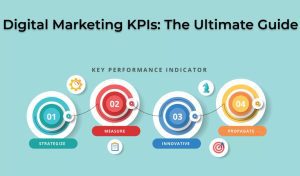Don’t Launch a Digital Marketing Campaign Without Tracking These 4 Critical KPIs
Are you tired of launching digital marketing campaigns that fail to deliver the results you’re looking for? It’s time to stop guessing and start tracking. In today’s fast-paced digital world, it’s essential to track key performance indicators (KPIs) to ensure your campaign is on track and driving the desired outcomes.
In this blog post, we’ll dive into four critical KPIs every marketer should be tracking before launching any digital marketing campaign. Don’t waste another dollar or minute without these game-changing metrics at your fingertips. Let’s get started!
Introduction to Digital Marketing KPIs
Digital marketing KPIs are the metrics used to measure the success of your digital marketing campaigns. Without tracking these KPIs, you won’t be able to improve your campaigns or measure your ROI.
There are a number of important KPIs to track, but which ones you track will depend on your goals and objectives. For example, if you’re trying to increase brand awareness, you’ll want to track metrics like reach and impressions. If you’re trying to drive traffic to your website, you’ll want to track metrics like click-through rate and bounce rate.
No matter what your goals are, there are certain KPIs that are critical for all digital marketing campaigns. Here are the most important KPIs to track:
1. Reach: This is the number of people who see your content. If you’re trying to increase brand awareness, reach is an important KPI to track.
2. Impressions: This is the number of times your content is seen by people. Like reach, this KPI is important for measuring brand awareness.
3. Click-Through Rate (CTR): This measures how often people who see your content click on it. If you’re trying to drive traffic to your website, CTR is an important KPI to track.
4. Bounce Rate: This measures how often people who click on your content leave after viewing only one page. A high bounce rate indicates that people didn’t find what they were looking for on your website, so tracking this KPI can help you identify areas for improvement.
5. Conversion Rate: This measures how often people who click on your content take a desired action (such as making a purchase or signing up for a newsletter). If you’re trying to generate leads or sales, conversion rate is an important KPI to track.
By tracking these digital marketing KPIs, you’ll be able to get a better understanding of what’s working and what isn’t when it comes to your campaigns. This will enable you to make more informed decisions about where to allocate resources and how to optimize your campaigns for the best possible results.
What is a KPI?
A key performance indicator (KPI) is a metric used to evaluate the success of a digital marketing campaign. There are many different KPIs that can be tracked, but some of the most important ones include website traffic, conversion rate, and cost per lead. By tracking these KPIs, businesses can identify which aspects of their campaign are working and which need to be improved.
Website traffic is one of the most basic KPIs that should be tracked. It measures the number of people who visit a website after seeing a digital marketing campaign. If this number is low, it could indicate that the campaign is not effective in driving people to the website.
Conversion rate is another important KPI. This measures how many people take a desired action on a website after seeing a digital marketing campaign. For example, if a business is running a campaign to increase sales of their product, they would track the conversion rate of people who view the campaign and then go on to purchase the product. A low conversion rate could indicate that the campaign is not effective in persuading people to buy the product.
Cost per lead is another key metric for evaluating digital marketing campaigns. This measures how much it costs to acquire each new customer or lead through a digital marketing campaign. A high cost per lead could indicate that a business is spending too much money on their digital marketing efforts and not seeing a good return on investment.
Types of Digital Marketing KPIs
There are a number of important KPIs that should be tracked when launching a digital marketing campaign. Here are some of the most critical:
1. Website traffic: This is one of the most basic KPIs and measures the number of visitors to your website. It’s important to track this KPI to gauge the success of your digital marketing efforts in terms of generating interest and awareness.
2. Engagement: This KPI measures how engaged users are with your website or app. Engagement can be tracked in a number of ways, but common metrics include time spent on site/app, pages per visit, and bounce rate.
3. Lead generation: If your goal is to generate leads through your digital marketing campaign, then you’ll need to track how many leads are generated as a result of your efforts. This will help you measure the effectiveness of your campaign in terms of generating interest and converting leads into customers.
4. Sales: Of course, ultimately you’ll want to track how many sales are generated as a result of your digital marketing campaign. This will give you the clearest picture of whether or not your campaign is successful in terms of bottom-line results.
Essential Digital Marketing KPIs to Track for Your Next Campaign
As you plan your next digital marketing campaign, it’s essential to identify which key performance indicators (KPIs) you’ll track to gauge its success. Doing so will help you determine whether your marketing efforts are paying off and where you can improve.
Here are some essential digital marketing KPIs to track for your next campaign:
1. Website traffic. This is a basic metric that measures the number of visitors to your website. Keeping tabs on your website traffic will give you an idea of how well your campaign is driving people to your site.
2. Engagement metrics. Once people are on your website, you’ll want to track engagement metrics such as time on site, pages per session, and bounce rate. These metrics will give you insight into how engaged users are with your site content and whether they’re sticking around or quickly leaving.
3. Conversion rate. Another important KPI to track is your conversion rate, or the percentage of website visitors who take a desired action such as making a purchase or subscribing to your email list. A high conversion rate indicates that people are finding what they need on your site and taking the next step that you want them to take.
4. Social media metrics. If you’re promoting your campaign on social media, be sure to track relevant metrics such as likes, shares, and comments. This will give you an idea of how viral your campaign is and how much reach it’s getting on social media platforms.
– Conversion Rate
1. Conversion rate – The percentage of people who take the desired action on your website out of the total number of people who visit your site. This metric is critical for understanding whether your digital marketing campaign is successful in driving results.
2. Cost per conversion – The amount of money you spend on your digital marketing campaign divided by the number of conversions. This metric allows you to understand how much you are spending to acquire each new customer or lead.
3. Click-through rate (CTR) – The percentage of people who click on a link or ad from your website out of the total number of people who see it. This metric helps you understand how effective your website and advertising are in driving traffic to your site.
4. bounce rate – The percentage of people who leave your website after viewing only one page. A high bounce rate indicates that people are not finding what they’re looking for on your site, which can be a sign that your digital marketing campaign is not effective.
– Cost per Acquisition
As a digital marketer, one of your primary goals is to generate leads and convert them into customers. In order to do this effectively, you need to track several key performance indicators (KPIs). One of the most important KPIs is your cost per acquisition (CPA).
Your CPA is the total cost of acquiring a new customer, including all marketing and advertising expenses. To calculate your CPA, simply divide your total marketing costs by the number of new customers acquired.
While there is no magic number for an acceptable CPA, you should aim to keep your costs as low as possible. A good rule of thumb is to strive for a CPA that is less than half of your customer’s lifetime value (LTV).
To further reduce your CPA, consider using lead generation software that automates some of the lead nurturing process. This can help you save time and money while still delivering high-quality leads to your sales team.
– Return on Ad Spend (ROAS)
While there are many important KPIs to track when launching a digital marketing campaign, Return on Ad Spend (ROAS) is one of the most critical. ROAS tells you how much revenue your campaign is generating for every dollar you’re spending on ads. A high ROAS means your campaign is very efficient and generate a lot of revenue for each dollar spent. A low ROAS, on the other hand, indicates that your campaign needs improvement.
To calculate ROAS, simply divide your total campaign revenue by your total ad spend.
For example, if your campaign generated $10,000 in revenue and you spent $5,000 on ads, then your ROAS would be 2 (10,000 / 5,000).
Keep in mind that ROAS varies by industry and business type. For some businesses, a ROAS of 1.5 might be considered excellent while others might need a ROAS of 3 or 4 to be happy with their results.
What’s important is that you track your own campaigns over time and strive to improve upon your previous results. By constantly monitorin and optimizing your campaigns, you can ensure that you’re getting the most bang from your advertising buck.
– Lifetime Value (LTV)
Lifetime value (LTV) is one of the most important KPIs to track when launching a digital marketing campaign. Why? Because it tells you how much each customer is worth to your business over the course of their lifetime.
There are a few different ways to calculate LTV, but the most common is to take the average revenue per customer and multiply it by the average customer lifespan. This number will give you a good baseline for how much each customer is worth to your business.
Of course, LTV is just one KPI out of many that you should be tracking when launching a digital marketing campaign. But it’s an important one, because it will give you an idea of how much money you can realistically spend on acquiring new customers without losing money in the long run.
How to Set Up and Track Your KPIs in a Digital Marketing Campaign
To ensure your digital marketing campaign is successful, you need to set up and track key performance indicators (KPIs). By tracking KPIs, you can measure your progress, identify areas for improvement, and make necessary adjustments to improve your campaign’s overall effectiveness.
There are a number of different KPIs you can track in a digital marketing campaign. Some common ones include:
–Website traffic: This measures the number of visitors to your website. You can track website traffic using Google Analytics or other web analytics tools.
–Leads generated: This measures the number of leads (potential customers) that you generate from your digital marketing campaign. To track this KPI, you’ll need to use a lead tracking tool such as HubSpot or Marketo.
–Conversion rate: This measures the percentage of visitors who take a desired action on your website (such as making a purchase or subscribing to your email list). You can track conversion rate using Google Analytics or other web analytics tools.
–Cost per lead: This measures the cost of generating each lead from your digital marketing campaign. To calculate this KPI, simply divide your total marketing budget by the number of leads generated. For example, if you spent $1,000 on your campaign and generated 100 leads, your cost per lead would be $10.
–ROI: This measures the return on investment (ROI) for your digital marketing campaign. To calculate this KPI, divide your total profits by your total investments. For example, if you spent $1,000 on a campaign and earned $2,500 in profits, your ROI would be 150%.
Once you’ve identified the KPIs that you want to track for your marketing campaigns, it’s time to set up tracking systems. You can use web analytics tools such as Google Analytics or other specialized software packages to track KPIs. Once you start collecting data, make sure to regularly review the results so that you can identify areas where improvements need to be made. With regular analysis and optimization of your digital marketing campaigns, you’ll be able to maximize the effectiveness of your efforts and achieve the best possible results.
Conclusion
To sum it up, tracking the right KPIs is essential to making an effective digital marketing campaign. Knowing which KPIs are important and how to track them will ensure that you have a successful campaign and get the best return on your investment. With this information in mind, you can launch your digital marketing campaigns with confidence knowing that you are measuring the success of each one and setting yourself up for long-term success.




